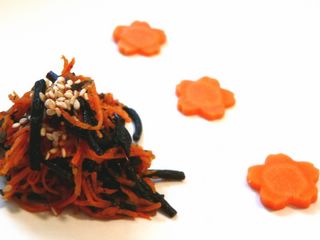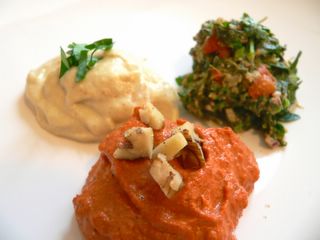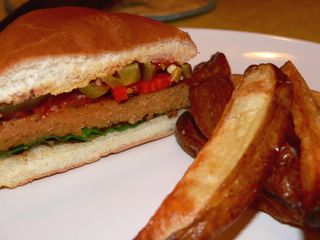 traditional japanese hot amazake drink with a pinch of fresh grated ginger
traditional japanese hot amazake drink with a pinch of fresh grated gingeramazake is sneaking it's way into the american culinary consciousness. you may have seen little bottles of the stuff lurking in the refrigerated section of your local health food store, all cozied up next to the spirulina and camel dung health drinks. you know what i'm talking about, those little shakes that use amazake as a base along with nuts, fruits and various flavorings. they're thick, creamy, sweet and, of course, expensive.
for the uninitiated, amazake is nothing more than cooked grain (white or brown rice being the most common but other grains can also be used) innoculated with
aspergillus oryzae in the form of koji and allowed to ferment for anywhere from 12-24 hours. the aspergillus breaks down the grain's carbohydrates into simple, unrefined sugars. the end result is a thick, sweet porridge with a very distinctive flavor. if it tastes a bit like sake to you, you are not mistaken. this is the first step in making sake (and miso and shoyu and shochu too). ama means sweet, and zake (the z is just a spelling change) stands for sake, for which we need no translation. despite this slight taste resemblance to sake, amazake is not alcoholic.
 coco amazake
coco amazakeduring the winter months in japan amazake is drunk steaming hot, diluted with water and seasoned with fresh grated ginger. i like my amazake served in this manner, but you could add other seasonings like cinnamon, nutmeg and ginger and have a sort of non-egg nog grog. or you could mix with cocoa powder and have a naturally sweetened hot chocolate drink. on the cooler end of the spectrum, you could use it to as a sweetening agent for shakes and smoothies. it is said that amazake has certain leavening powers and can be used in baking.
so, if you're into fermenting and culturing, like i am, or if you like to drink amazake but don't like to pay the big price tag, homemade might be the way to go. the process is really quite simple. first you will need the following items:
 koji
koji
koji
rice or other grain
thermometer
incubator
vessel
koji can be found in most japanese markets or online. it is nothing more than rice grains that have already been innoculated with the aspergillus. i buy it pre-prepared in the tubs pictured above. if, however, if you would like to try to make koji at home (which requires rice, the aspergillus spores plus another long fermentation), you can order the spores from
gem cultures. i buy my koji premade since it saves so much time.
 in the incubator
in the incubatornext comes the most difficult part of the process...jerry-rigging an incubator to suit you needs. for my
homemade tempeh i just use my gas oven. the pilot light keeps the tempeh at about the right temperature. amazake however should be incubated at a slightly higher temperature (130 - 140f; 55-60c).
two incubator set-ups have worked for me: 1. the oven method: in my gas oven i place a cheap-y desk lamp with a 60 watt bulb, plug it in and close the door. in my oven this keeps the temperature at around 130 degrees and the amazake is done in approximately 12 hours; 2. the heating pad method: this is how my mom does it, and it takes a little longer but is less hassle. just wrap your rice and koji filled vessel in a towel and wrap inside an electric blanket or heating pad. the temperature setting to keep your blanket on will vary. on high, my little heating pad runs at about 120 degrees and the amazake is done in 22 hours.
now that we have the basics in order, let's get fermentin!
1 cup white rice, brown rice or other grain (millet, etc.), washed and drained
2 3/4 cups water
2 cups koji
1. cook rinsed rice in water at a low simmer for 30 minutes for white rice, 50 minutes for brown rice, or use a rice cooker if you have one. due to the water:grain ratio, the rice should be slightly porridge-like.
2. cool to about 140 degress farenhite (60 degrees celcius) and add koji. i use a thermometer to test the temperature but you can test with your finger - it should be just cool enough that your digit can tolerate the heat and not immediately blister but not so cool that it can linger. maybe like a really hot bath. thoroughly combine the rice and koji and place in a crock, glass jar or pyrex baking dish and cover.
3. incubate at 130 - 140 f (55 - 60 c) for 10-14 hours. if you can't get the incubator hot enough, process for an additional 5 - 10 hours until the rice is very sweet and the grains are very soft.

 before incubating and after 22 hours at about 120 farenhite
before incubating and after 22 hours at about 120 farenhite4. when the rice is meltingly soft and very sweet, place in a covered saucepan and simmer for 10 minutes to stop the fermentation.
be very careful not to burn it like i did my first time. after cooking, you may place amazake in a blender and puree until all rice grains are incorporated and the amazake resembles a thick pudding, or leave it as is. this is your base and you can use it thinned out to make the traditional japanese drink, dilute with water, nuts and seasonings to make a shake, or use it in baking as a honey substitute.
 pureed amazake, undiluted
pureed amazake, undilutedfor more information on amazke, you can follow these links:
cybermacro has a nice little write up of the amazake making process and also sells koji online
gem cultures the great-grandaddy of all things fermentable, you can buy just about any kind of starter here, from keffir to tempeh to aspergillus to timbuktu.
dom's culture pages. he's a fermenting fool and has some nice write ups about a variety of fermentables.


























